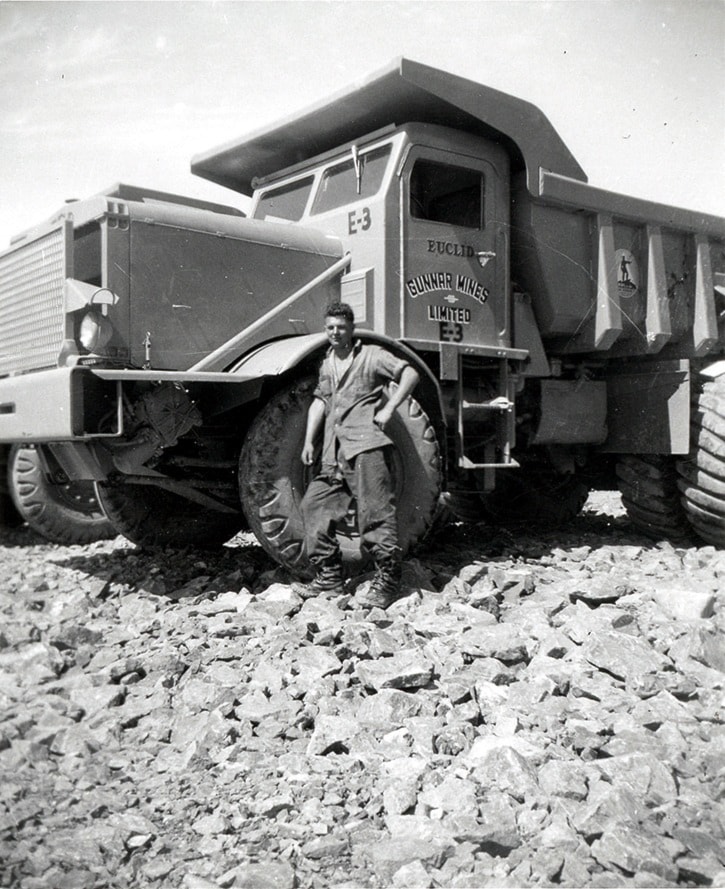South Surrey writer Patricia Sandberg admits she has mining in her blood – although she claims her former career as a securities lawyer for mining companies came about more as a matter of accident, than design.
The fact remains that both her grandfather, Fred, and father Jack, were both deeply involved in the construction end of the mining industry and had an extended working relationship with 20th century Canadian prospector and mining pioneer Gilbert LaBine, first president of Eldorado Mining and Refining from the late 1920s until 1947.
The uranium boom of the late 1940s led LaBine to discover deposits of the metal on the shores of Lake Athabaska in Northern Saskatchewan. In the early 1950s he established Gunnar Mines there – and the company town that was built around it.
And that's where Sandberg grandparents and parents – and Sandberg herself – moved in 1954, and stayed for some 10 years until mining operations, and the town, wound down in 1964.
It's a connection that makes Sandberg particularly suited to write the story of the short-lived, yet vital community.
And her forthcoming book, Sun Dogs and Yellowcake, supplies not only a missing, and particularly Canadian, chapter of history, but celebrates and memorializes a vanished way of life.
Set for publication early next month, the book will have its official launch Sept. 14 at 7 p.m. at the Turnbull Gallery, 14601 20 Ave. (in the South Surrey Recreation and Arts Centre).
Sandberg explains that the 'sun dogs' referred to in the title are optical illusions in the northern atmosphere that create multiple mirror images of the sun on the horizon, while 'yellowcake' is uranium in its purest, refined powder form.
Sandberg is keenly aware of some of the ironies of the account she has woven – much of it told in the words of some 150 former Gunnar residents she interviewed.
The huge dollar value of uranium and the resulting rush to prospect for it in Canada's north was the subject of great excitement and even humour during the era – Sandberg noted that a whole show by radio and television comedian Jack Benny was built around his miserly desire to get in on the boom.
At the same time little thought was given to the fact that uranium was being produced and stockpiled for only one real reason – to build the U.S.' arsenal of nuclear weapons.
The close-knit community of Gunnar was almost the quintessential 1950s crew-cut and bobby-sox environment – a mixture of post-war exuberance and naive innocence – transplanted to a remote and rugged region not reachable by roads, and four hours by air to the nearest exit point, Edmonton, Alta.
There was no television reception, but there were movies in the community centre that also served as a church for different services each Sunday, and curling was a daily activity during the winter.
The town had its own volunteer radio station, a Hudson's Bay store, a bank, modern houses and two apartment buildings – and what may have been the first covered mall in North America, Sandberg said.
And while a two-room school provided adequate education for the children ("I didn't do too badly by it," Sandberg said) they also had an unparalleled freedom to explore the wilds.
Environmental regulations didn't exist and nobody considered the health aspects of ongoing exposure to uranium to workers and families, Sandberg said, adding that souvenir lamps made of uranium 'drill core' sat in many Gunnar living rooms, along with coffee-table mementos of the first production in 1955 that included plastic-covered inserts of genuine yellowcake.
"We were all exposed to uranium in so many ways. All the kids were playing in the tailings ponds. The tailing ponds were located above the residences of the managers and the hospital. Nobody thought there was any chance of harm."
But – while suspicions still linger among past Gunnar residents that some miners' lives were shortened by exposure to the metal – the book is not fashioned as an indictment, Sandberg said.
More, it is an attempt to recapture the atmosphere of a lively community that, at any one time, included between 800 and 900 people, from miners, engineers and construction workers, to teachers, clerical workers, nurses and teachers, and their families.
"Many people who came to the community were refugees, from Germany, Italy, Scotland and Ireland and later on Hungary – a huge mix of different people and a relatively small group of Metis and First Nations, and they all seemed to get along.
"There were exceptions but the sense of community that little town had was kind of remarkable. When I was phoning up people I knew from more than 50 years ago, almost to a person they said it was the best place they ever lived."
Sandberg said the original inspiration of the book was a desire to get down on paper some of the Gunnar-era stories of her mother, Barbara ("she's still very much with us and has a far better memory than I ever had or will have.")
Serendipitously, it expanded as more and more people volunteered memories and help.
"It all kind of fell into place," Sandberg said, adding that what was originally intended as a story of the town's residents grew naturally to include background history of the mining industry – and a postscript tracing the current Saskatchewan government's efforts to remedy the environmental effects of the abandoned Gunnar mine and community.
"I think this is a really important mining story," she said, adding that an understanding of the role of mining is vital to understanding Canadian history.
"Whether you like uranium or not, we need to celebrate Canada's mining and what Gilbert LaBine and many other prospectors did, and the ingenuity, daring and foresight they brought to the endeavour."
For more information of Sun Dogs and Yellowcake, visit www.PatriciaSandberg.com
